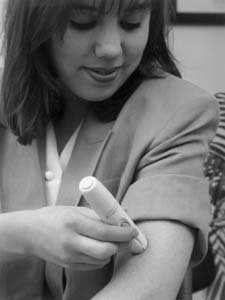Shot in the Dark
By J. Douglas Allen-Taylor
For those of us who have long feared the invasive tyranny of the doctor's needle, the future has always held out hope of relief. The future as defined in science fiction movies, anyway. In the brave new world as defined by Hollywood, injection by syringe is no more.
In Escape From L.A., for example, which takes place in the year 2013, Kurt Russell's character, Snake Plissken, learns that government representatives want to coerce his cooperation in a rescue project by injecting him with a deadly virus. "Which one of you assholes gets to die trying to stick me?" Plissken asks. He soon learns that sticking is no longer necessary; a government agent has already infected him by a mere scratch on the back of his hand.
Nobody wants a virus, of course, but it certainly beats a long, pointy piece of metal jabbing deep into the skin.
The various Star Trek series go one better, of course. From Bones to Bashir to that chatty holographic fellow, Star Fleet physicians are all equipped with medical devices that insert medicines into the body with just a brief pass over the surface of the skin. It must be painless, as the patients never even flinch. Makes you want to hang around until the appropriate star date, just for the chance to get away from needles.
Maybe you don't have to wait that long.
PowderJect, a British-based company with laboratories in the Fremont marshes, is in the second phase of clinical testing of an injection device that sends vaccines and drugs into the body without even having to break the skin. Instead, the device sends particles so fast--2,000 miles an hour, or three times the speed of sound--that it just blows past the cells of the skin without even disturbing them. The device is expected to be available for public use late in the year 2000.
PowderJect vice president Gordon Saul bounces one of the devices in the palm of his hand. It has the size and the feel of a small electric toothbrush, though it needs no wires. The injection is powered by a small, disposable cannister of highly compressed helium.
"This is a lot different from those old liquid jet injectors that they used in schools and in the army," Saul says. "You might not feel the penetration of the skin itself from one of those injection guns, but they force the liquid up under the skin. Until it disperses, it can cause a lot more pain than a needle injection."
By contrast, PowderJect changes vaccines into powdered form. For most applications, the individual powder particles are only about five times the size of the cell, and they simply disperse themselves around the cells. But for some special applications such as the injection of genetic material, the powder particles are small enough to be able to go directly into the cells themselves. The technology is already available for direct injection through the skin, the mouth and the vagina, and PowderJect is now working on developing systems for injections into internal organs and the eye.
"The idea is a simple scientific principle: You've got to have a sufficient mass of material traveling at a sufficient speed in order to pass through the outer layer of skin," Saul explains. He says that solving the problem of getting vaccines and drugs between the cells was not all that difficult, given the present state of technology. But engineering the entry into the cells themselves--as is required for DNA vaccines--was a little more daunting. "We found that when we had made the molecules small enough to enter the cells, they had also lost so much of their density that they couldn't penetrate the skin," he says. "So we had to coat them in gold in order to make them dense enough." Each molecule? "Yes, each molecule," Saul says, though he never lets on how that is done.
Saul says the cost of one of the throwaway devices will be about $1.50 per application (not taking the cost of the drug itself into account), while the single use of a reusable device will be about 50 cents. This is about twice the cost per use for a syringe. But Saul says that does not take into account other costs of the use of needles. "The real savings will be in getting people to inject their own medicine rather than relying on a hospital or a doctor," he explains. "PowderJect devices are designed to be used by patients themselves. The other cost benefit will be in the elimination of needle accidents. You're not going to run the risk of sticking somebody with an infected needle."
I left to the last the most important question: Does the PowderJect injection hurt? "No," Saul replies, with a benevolent smile. Yeah, sure. That's what my doctor always tells me. For that one, we'll just have to wait until Y2K to see.
[ San Jose | Metroactive Central | Archives ]
Copyright © Metro Publishing Inc. Maintained by Boulevards New Media.
![]()
 Fremont firm catches up with science fiction, markets needle-free injections
Fremont firm catches up with science fiction, markets needle-free injections
From the August 6-13, 1998 issue of Metro.
![[Metroactive Features]](/features/gifs/feat468.gif)